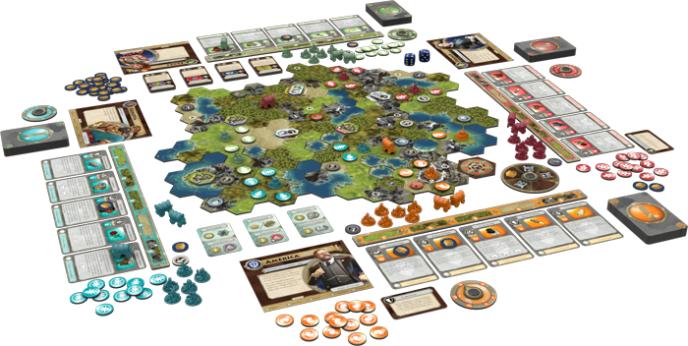The Civilization: A New Dawn Board Game Might Be Too Streamlined

If you’ve played videogames at all in the last 30 years, you’ve probably at least come across Sid Meier’s Civilization franchise, which popularized the game genre known as 4X: eXplore, eXpand, eXploit and eXterminate. First released in 1991, the edition that occupied my time for most of the first semester of my junior year at college, it was itself inspired by a 1980 board game of the same name and by the Empire war games of the 1970s, as well as Meier’s own earlier hits SimCity and Railroad Tycoon. The original Civilization began in 4000 BC and had players start out with one primitive village, exploring the area around them to acquire resources, develop technologies (traversing a “tech tree” of prerequisites); building roads, factories, and Wonders of the World; and, of course, beating the hell out of their opponents. It was incredibly addictive, and subsequent editions have gotten more detailed and longer to play, with the latest edition, 2016’s Civilization VI, apparently as addictive as ever.
I’ve largely avoided the game since the third edition because of the time commitment and my tendency to play it to the exclusion of all other activities short of respiration, and didn’t play the 2010 board game adaptation from Fantasy Flight Games because it suggested a minimum required playing time of two hours (which means you’re probably looking at three-plus). FFG has mitigated that concern with the new version of the game, Civilization: A New Dawn, which came out in December. Rather than stripping out most of the rules from its predecessor or the videogame franchise, this takes the theme and the look of the other games and builds a simpler rule set on the same chassis. That has its pros and cons—while this will definitely feel like Civilization to folks who’ve played any of the earlier titles in the series, it might be too bare-bones to scratch that 4X itch.
Civilization: A New Dawn is designed for two to four players and can be finished in about an hour once you get the hang of the rules. The board is variable in size and shape, and includes hexes of five terrain types plus water spaces. Each player starts with one capital city on the board, and will be able to add up to seven more cities over the course of the game. Players explore the board by placing control tokens on hexes adjacent to their cities, and later adjacent to other control tokens as well; these tokens can be unreinforced or reinforced, which matters if they’re attacked by other players or barbarians, neutral units that move around the board in semi-random fashion.
Each player begins the game with the same five Focus cards, which prescribe the actions the player may take; they’re arrayed in a row under a frame that shows the five terrain types under the numbers 1 through 5. On your turn, you choose one of the five actions and execute it, using the number and/or terrain type to fill in certain variables on the card. If the action you choose involves placing control tokens or building a city, you can only place or build on hexes with terrain types matching the one above the Focus card or those to the left (lower in value/difficulty). If you wish to build a Wonder, the number above the card is the base value to build it, to which you’ll have to add resources. If you attack another player, barbarian or neutral city-state, your base attack value is the number above the card. These five cards are all Era I at the start of the game, and you can advance your tech dial or use other bonuses to upgrade them over the course of the game, up to Era IV cards, which are the most powerful. After you use a card, you move it to the left of the queue and move all cards one slot to the right to fill in the open space, a mechanic that’s become much more common in games the last two or three years (Asmodee’s Otys, released earlier this year, has it too).
